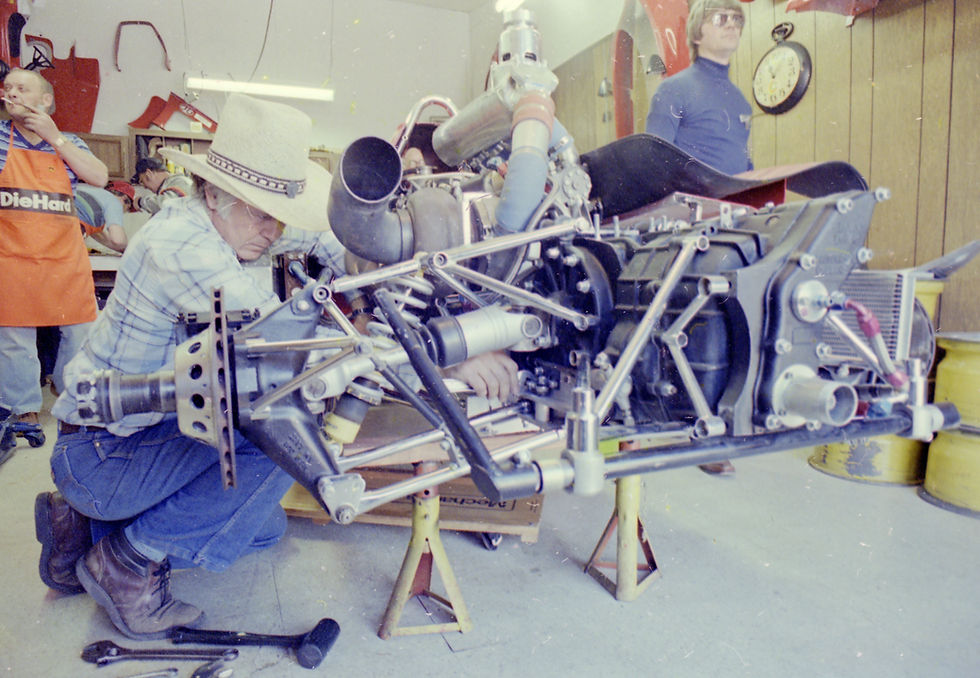Images from the Brickyard: Bob Linder’s Indy 500
- Michael Price
- May 23, 2025
- 7 min read
Updated: Jul 23, 2025
Each year on Memorial Day weekend, more than 300,000 fans witness the “greatest spectacle in racing”: the Indianapolis 500. Few events of any kind can match its long history. The first race was in 1911 when the 2.5-mile speedway was covered with bricks, earning it the nickname “The Brickyard.” The race has occurred every year since, except during World War I and World War II, and has seen the evolution of technology and increasingly more iconic moments. From the yard of bricks at the start and finish line to the winner entering motorsports history with a drink of milk, every aspect of the event blends tradition into a modern spectacle witnessed around the world.
In 1978, 1979, and 1981, Springfield Newspapers Inc. sent staff photographer Bob Linder and sports journalist Kirby Arnold to cover the race. The photos in this piece are all courtesy of the Bob Linder Collection. Arnold loved Indy, but Linder was a fan of sports cars and road courses. “The first time I saw the speedway, I was blown away at how big it was,” Linder says. “On the inside on one end was a golf course and the other a museum and parking and all the support buildings. The grandstands went on forever.” While his images document the magnitude of the event and highlight famous drivers, they also illustrate life behind the scenes during the Speedway’s epic month of May. Through Linder’s lens we see teams working in the garages of Gasoline Alley and drivers discussing strategy with pit crew members.
Before the race, crowds gather on the starting grid. Linder recalls: “Race day is intense for everybody. It is such a spectacle seeing so many people in one place. I had a media pit pass, but you had to stay in your area and out of the way. Right before the race begins, all the cars are on the track, and there were a few minutes when I could venture out on the grid and get a few quick shots.” Cars are towed to the track via the Gasoline Alley garage. “Gasoline Alley reminded me of a stable,” Linder says. “[It was] really old and wooden, and people and cars squeezed in. You were right there with Mario Andretti, Roger Penske, Jim Hall, and other legends of auto racing. They were focused but relaxed, and often you could talk to them.” It was in these moments of stillness that Linder was able to photograph the coveted front row qualifiers up close, moments before they tore across the speedway at hundreds of miles an hour. In 1978, he captured the three fastest qualifiers, including Tom Sneva, who earned the pole position with a top speed of 202.516 mph.
Photography at 200 Miles per Hour
Many of Linder’s photographs were taken on pit road or in the garage area as drivers and crew members prepared their cars for the race. Linder quickly discovered capturing race cars as they sped through his lens was a unique challenge. He found a spot on the inside of turn 1 and followed cars with his camera as they passed by. “‘Not bad,’ I thought, and then I realized they were just warming up,” he says. “As speeds were approaching 200 mph at that time, I saw I was going to have to really concentrate to spot the car I wanted and be prepared to follow it.”

Just Trying To Qualify
Only a select few drivers accomplish their dream of winning the Indianapolis 500. For many others, merely qualifying for the race is a career milestone. Each year, only 33 drivers make the starting lineup. Simply making the field could feel like a victory for drivers like John Martin. Martin had previously lived in Houston, Missouri, which gave the newspaper a local angle to cover at the race track. Arnold’s article and Linder’s photographs illustrate the struggle of an independent racer fighting for a coveted starting spot at the Brickyard.

As with many drivers in his position, Martin came to the track looking for a ride; although how he got in that position was unique. He planned to drive a car for J & J Enterprises in Grand Junction, Colorado. Unfortunately, the team’s transporter was involved in an accident shortly after leaving the shop. Methanol racing fuel in the car caught fire during the crash, and everything was destroyed. Martin estimated the team lost $150,000 worth of equipment. “But what the car was valued at and what it costs to replace are two different things,” he noted. “The engine was irreplaceable. I worked on that thing for months.”
Undeterred, Martin went to the speedway with his helmet in hand looking for a ride. He soon made a deal with Metro Racing, a small team with limited resources. Ironically, their car was familiar to Martin — he drove it in the Indy 500 three times from 1973 to 1975. Martin and his small crew were assigned to Garage 78 in Gasoline Alley right next to Penske Racing and their three cars with millions of dollars in sponsorship. Martin proudly named his car the “Unsponsored Special” and set to work trying to make the field.
Days of practice at Indianapolis help drivers get their cars ready for the qualifying period. The work and stress, however, take a toll. During a caution period Martin went to sleep sitting in the cockpit of his car. The booming voice of the track announcer over the PA system woke Martin up. About his little nap, he told reporters: “It’s always a strain here. It’s more of a strain on the new guys, but there is an awful lot of pressure on everybody. I work on the car. I make sure people are getting to and from the airport. I make sure everybody’s got motel reservations.”


Martin’s stress worsened as he struggled to get his car up to speed for the unique qualifying procedure at Indianapolis. Instead of a customary one-lap qualifying round, drivers run four laps. Their average speed over those laps is their official time. The challenging format forces teams to make their cars fast, but also consistent over the 10 miles. On the third day of the qualifying procedure, Martin’s official time was 177.655 mph — good enough for the 33rd and final spot on the grid. That put Martin on Indy’s famous bubble, or the first car to be knocked out by someone faster. The track announcer noted, “You could use a few more miles per hour, John.” “Yeah, like about 40 mph,” a dejected Martin said. Committed to a stock car race the next day, Martin hoped his speed would hold up as rain threatened to cancel the last day of the qualifying round. Those hopes were dashed when Pete Halsmer beat Martin’s time and bumped him from the field.
A Disputed Finish
On the other end of the grid, Bobby Unser won the pole position with a speed of 200.546 mph. He went on to take the checkered flag for his third victory in the 500, but a bitter controversy marred the finish. Race officials determined Unser passed cars under caution on lap 149. In Indycar racing, when a caution flag is up, cars must slow down and maintain their position. He was penalized one lap, and second place finisher Mario Andretti was declared the winner. Unser and his team appealed, and the dispute dragged on for months. Ultimately, a committee was appointed to resolve the issue. They decided that, while Unser had passed cars under caution, the penalty was too severe. He was fined $40,000, and his victory was restored.


Legends of the Brickyard
Bob Linder’s photographs captured some of the greatest drivers in Indianapolis 500 history as they prepared for the race and challenged the brickyard at over 200 mph.
Indianapolis 500 legends are built on repeat wins. For the Unser family, victory runs in their DNA: Bobby Unser is a three-time winner, and his brother, Al, is a four-time winner. Rick Mears has also captured the checkered flag four times.
Mario Andretti only won the Indianapolis 500 once (in 1969), but that distinction was enough to make him the only driver to win the Indianapolis 500, the Daytona 500, and the Formula 1 World Championship. In 1978 (pictured) Andretti was still competing in Formula 1 and missed the qualifying round in Indianapolis while in Europe for the Belgian Grand Prix. He won that race while another driver qualified his car at Indianapolis. The driver change forced him to start last, and he finished the race with mechanical trouble. In the 1981 race in which Bobby Unser won after passing under caution, Andretti claimed he won as the rules were written. Despite Unser having his victory restored, Andretti kept the winner’s ring.
Like Andretti, A.J. Foyt won iconic races in multiple disciplines such as the Daytona 500 and the 24 Hours of LeMans. In 1977, he became the first four-time winner of the Indianapolis 500 — a feat achieved by only three other drivers. Others, like Johnny Rutherford, could only bag three victories. Rutherford, in his signature yellow Penzoil car, won his third Indianapolis 500 in 1980. In 1981 he qualified fifth but left the race with mechanical trouble after 25 laps, never to win another Indianapolis 500.
To learn more about the Indianapolis 500 and one of its most famous drivers, check out the new biography A.J. Foyt, Vol. 1: Survivor, Champion, Legend by Art Garner. You can also explore the rich history of auto racing in the Ozarks via the Library’s digital collection, The Fairgrounds & Beyond. See more of Bob Linder’s photographs from his nearly 40 years with Springfield Newspapers Inc. online at the Bob Linder Collection.
For Further Reading
“Martin’s Diary: Detailing Indy Failure," Springfield (Mo.) News-Leader, May 24, 1981, 1, 3 F.




















